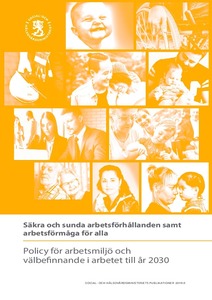New Finnish work environment policy
Psychosocial strain of work will increase as the transformation of work accelerates. We must therefore take a more comprehensive approach to risk assessments. That is the main message from the Finnish Ministry of Social Affairs and Health’s new policy for the work environment until 2030.
The new policy, edited by Ministerial Counsellor for Health/Medical Affairs Riitta Sauni, has been developed in cooperation with labour market organisations and other partners.
“The new policy covers the most important issues which also featured in the old policy. But now the emphasis is on the changes to the labour market and future challenges,” says Riitta Sauni.
“One of the aims that are included in the policy is for work to be safe and healthy in all workplaces, regardless of the type of work being carried out. Risk assessments should take into account physical, chemical, biological, psychological and social risks in a comprehensive manner,” she says.
The content of work, workplaces and occupations change, however, which calls for a continuous updating of the policy.
Fewer routine jobs
Routine jobs become rarer, while both high and low skilled jobs will probably increase in number in the future, the policy points out.
The physical strain caused by work is likely to decline or at least change. At the same time, work becomes increasingly mentally stressful and the demands of brainwork gain emphasis. Artificial intelligence will also supplement work requiring a high level of competence.
Megatrends, such as digitalisation, globalisation, demographics, urbanisation and climate change are driving the change. This in turn changes the way people work, the contents of work and not least the relationship between employers and employees.
“Any risks associated with new technology and different ways of working should be identified, prevented and minimised. At the same time it is important to make use of the opportunities new technology and different ways of organising work can bring,” says Riitta Sauni.
More deaths in Sweden, record low numbers for Finland
Sweden has seen a worsening in the number of workplace deaths.
“This year alone 12 people have died at work. This is unacceptable,” wrote six Swedish government ministers in an opinion piece in March this year.
Sweden’s work environment strategy for 2016-2020 states the aim should be zero fatal accidents. In Finland, Nolla tapaturmaa (Zero Accidents) has been a successful measure since 2003. The new Finnish policy says that in this context, zero is not a numeric goal but rather indicates a vision to aim for. 14 people died at work in Finland in 2017.
“This is a record low figure, but it is still not possible to draw conclusions about a reduction of workplace accidents after just one year,” points out Riitta Sauni.
Promoting functional capacity, workability, and employability is also high on the agenda.
From both a human and economic perspective, it is important to take care of the workability and functional capacity of people of working age, career lengths, and the opportunities of those with partial workability to be involved in working life.
- Guidelines important in a political vacuum
-
Prime Minister Juha Sipilä and his government stepped down on 8th March this year after failing to pass its health care reform. No new government has been formed since the 14th April election.
In a political vacuum, it is important to have guidelines for what government ministries and civil servants should prioritise.
In Finland, a tradition has evolved that governments must have a parliamentary majority. The Social Democrats, the election winner, is most likely the party which will form a government together with some of the other parties.
It is hard to say how long this will take. There is a risk that attempts will be blocked, like they were in Sweden where it took 134 days to form a government after the election.
“Finland inherits Swedish headache” read the headline of an analysis piece in the Danish Politiken newspaper. It pointed out that the True Finns no longer could be considered a possible coalition partner, because party leader Jussi Halla-aho had taken the party even further to the populist right when it split in 2017. All of the party’s government ministers created a new party, Blue Reform, which only secured one percent of votes in the election and disappeared into the wilderness.
“The True Finns’ values are so distant from those of other parties. And when they also form the basis for everything else, the party cannot become a government party in its current form and with its current leader,” wrote Tommy Westerlund in Hufvudstadsbladet.

 Follow us on Facebook
Follow us on Facebook
